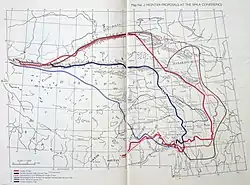Kingdom of Chakla
Kingdom of Chakla (Tibetan: ལྕགས་ལ་རྒྱལ་པོ, Wylie: lcags la rgyal po, THL: chakla gyalpo ; Chinese: 明正土司; pinyin: Míngzhēng tǔsī) or Chala[1] was a kingdom in the Tibetan region of Kham.
Kingdom of Chakla ལྕགས་ལ་རྒྱལ་པོ | |||||||
|---|---|---|---|---|---|---|---|
| 1407–1950 | |||||||
 Chala marked at the southeastern corner of Tibet (red boundary)[lower-alpha 2] | |||||||
| Capital | Dartsedo (present day Kangding) 29.999°N 101.957°E | ||||||
| Common languages | Gyarung | ||||||
| History | |||||||
• Established | 1407 | ||||||
• Disestablished | 1950 | ||||||
| |||||||
| Today part of | |||||||
Chakla along with Bathang, Lithang, and Derge were called the "Four Great Native Chiefdom in Kham" (康区四大土司) by Chinese.[2]
The kingdom was located in the eponymous Chakla region, near the historical border between Tibet and China. By the late 1200s, it had been founded around the city of Dartsedo, now known as Kangding. Due to its position, the town formed a trading centre for merchants from Tibet and China, who traded goods such as tea, traditional medicines, horses, and paper; for this reason the Ganden Phodrang government established a taxation regime in the kingdom, headed by a commissioner. The local kings resented the taxation coming from Lhasa, resulting in a rebellion in 1666, backed up by Chakla allying with the emerging Qing dynasty. Ganden Phodrang forces invaded five years later, followed by the murder of the king of Chakla by the commissioner in 1699. However, a year later, the commissioner was killed himself by Qing forces, who reorganised their Tibetan provinces in 1725, removing Chakla from Ganden Phodrang rule.[3]
The Kingdom of Chakla was annexed by Qing dynasty in 1911; Zhao Erfeng forced the king to abdicate.[4] However, ruler of Chakla had high prestige in Xikang and the Republican Chinese government had to allow them to restore him. Finally, the kingdom was annexed by the People's Republic of China in 1950.[5]
Notes
- Map from the 1914 Simla Convention: red line showing the frontier of Tibet as per the Convention and the blue line showing the boundary between the autonomous 'Outer Tibet' and the 'Inner Tibet' designated for Chinese administration.
- Map from the 1914 Simla Convention: red line showing the frontier of Tibet as per the Convention and the blue line showing the boundary between the autonomous 'Outer Tibet' and the 'Inner Tibet' designated for Chinese administration.
References
- Lamb, Alastair (1989), Tibet, China & India, 1914-1950: a history of imperial diplomacy, Roxford Books, p. 7
- "清王朝敕封的康区土司". Archived from the original on August 13, 2015.
- Ronis, Jann (July 13, 2011). "An Overview of the Chakla Kingdom". The TIbetan and Himalayan Library. Archived from the original on 8 December 2016. Retrieved 24 May 2017.
- "明正土司考略". Archived from the original on 2013-06-01. Retrieved 2018-12-24.
- "康区四大土司之明正土司". Archived from the original on 2018-12-24. Retrieved 2018-12-24.